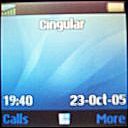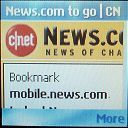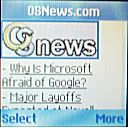REVIEW: Mid-Range Phone Sony Ericsson K300i
A lot of people prefer down to earth communication-only phones rather than powerful Swiss army knife devices. And then, there are those who like something in between. The Sony Ericsson K300i is such a device: a mid-range phone that at a good price ($158 at Geeks.com). Read more for the full review.
Hardware
 The phone sports a 700 mAh battery, a 128x128 65k CSTN display, a VGA camera, 10 MBs storage space, EMS/SMS/email support, GPRS class 10, infrared, 900/1800/1900 MHz GSM band support and Java MIDP-2. The small box it came with included a power supply, a manual and wrist-wrap. It didn't come with a USB cable (the DCU-11 cable is a separate purchase) or a handsfree.
The phone sports a 700 mAh battery, a 128x128 65k CSTN display, a VGA camera, 10 MBs storage space, EMS/SMS/email support, GPRS class 10, infrared, 900/1800/1900 MHz GSM band support and Java MIDP-2. The small box it came with included a power supply, a manual and wrist-wrap. It didn't come with a USB cable (the DCU-11 cable is a separate purchase) or a handsfree.
 Physically, the phone is one that we can call "small". It has the same dimensions as the popular K700i and it's very light. The construction quality is very nice and the blue color finish is also good-looking, much better than the similar but older Sony Ericsson model T310. The keys feel solid and they have a small sound feedback when pressed, helping the overall usability. The signature Sony Ericsson mini-joystick works well in the 5 directions it supports, while the device comes with three extra buttons: on/off button, camera button (at the side of the phone), web browser button (below the numerical pad). The camera and web buttons don't work if the phone is on standby (even if the keyboard is unlocked), which is a bit odd.
Physically, the phone is one that we can call "small". It has the same dimensions as the popular K700i and it's very light. The construction quality is very nice and the blue color finish is also good-looking, much better than the similar but older Sony Ericsson model T310. The keys feel solid and they have a small sound feedback when pressed, helping the overall usability. The signature Sony Ericsson mini-joystick works well in the 5 directions it supports, while the device comes with three extra buttons: on/off button, camera button (at the side of the phone), web browser button (below the numerical pad). The camera and web buttons don't work if the phone is on standby (even if the keyboard is unlocked), which is a bit odd.
The screen is a CSTN 128x128 65k which is nothing to brag about. It does the job well but being based on the CSTN technology it can not compete with any TFT screen in brightness or refresh speed.
Battery life is exceptional. It yield over 6 hours of talk time and after using the phone on GPRS for quite some time, the battery was still reporting as full.
Software
 I have used a lot of phones, from Nokia Series 40 to Motorola and from Symbian to Windows Smartphone, but Sony Ericsson's user interface tops all of them. The K300i uses the same software that the K700i and K750i use, which is a very easy to figure out, very easy to navigate UI. By being a mid-range phone it has enough options available to the user, but it doesn't feel as bloated or complicated as other phone UIs (e.g. Motorola's).
I have used a lot of phones, from Nokia Series 40 to Motorola and from Symbian to Windows Smartphone, but Sony Ericsson's user interface tops all of them. The K300i uses the same software that the K700i and K750i use, which is a very easy to figure out, very easy to navigate UI. By being a mid-range phone it has enough options available to the user, but it doesn't feel as bloated or complicated as other phone UIs (e.g. Motorola's).
The phone supports SMS and EMS which was hassle-free to setup and send rich messages. It also supports pop3/imap emailing, which worked perfectly with my eugenia.co.uk pop3 account. The K300i comes with WirelessVillage support from YamiGo (under menu items "Messaging/My Friends"). Through this free service you can connect to ICQ, AIM, Y! and MSN (however most phones don't display more than 20-30 buddies at a time and this was a problem for me, as I have over 100 buddies but only 20-25 are online at any given time -- the IM client shows the offline buddies too you see and so it overflows). When moving the joystick towards the left, there is a shortcut which loads a menu to send over SMS and MMS/EMS, but unfortunately that shortcut doesn't also include a "send email" or "send IM" or "send voicemail" option too.
 The K300i also comes with a Calendar, Tasks, Alarms, Notes, a Unit Converter, Timer, Stopwatch, Calculator, an easy to use file manager, a media player which can playback .3gp and mp3s, a sound recorder, MusicDJ (let's you create your own ringtones), two java games and PlayNow which allows you to hear to ringtones off the web before you purchase them. The video playback facility supports only .3gp files, apparently .mp4 are not supported (they are supported on the K700i). I found the performance of the UI and its applications very good, in fact the "frozen UI" effect that plagues the latest firmware of the K700i every minute or so for 1-2 seconds, does not happen on the K300i.
The K300i also comes with a Calendar, Tasks, Alarms, Notes, a Unit Converter, Timer, Stopwatch, Calculator, an easy to use file manager, a media player which can playback .3gp and mp3s, a sound recorder, MusicDJ (let's you create your own ringtones), two java games and PlayNow which allows you to hear to ringtones off the web before you purchase them. The video playback facility supports only .3gp files, apparently .mp4 are not supported (they are supported on the K700i). I found the performance of the UI and its applications very good, in fact the "frozen UI" effect that plagues the latest firmware of the K700i every minute or so for 1-2 seconds, does not happen on the K300i.
The included Sony Ericsson 4.0.3 web browser works pretty well with most lite html web sites, but it fails when something more complex comes to the mix. For example, gnomefiles.org would render, but gnomefiles.org/app.php?soft_id=24 wouldn't. However, all WAP sites render as they should which is what most users of this phone should try to use anyway.
Communications
 Being a low-end to mid-range phone it doesn't come with Bluetooth, but it does come with Infrared support. I tried the IrDA with my Windows PC and my PocketPC PDA. It worked perfectly with the PocketPC and my PC sending and receiving files and even worked great as a modem (using the PDA to dial to GPRS via Infrared).
Being a low-end to mid-range phone it doesn't come with Bluetooth, but it does come with Infrared support. I tried the IrDA with my Windows PC and my PocketPC PDA. It worked perfectly with the PocketPC and my PC sending and receiving files and even worked great as a modem (using the PDA to dial to GPRS via Infrared).
Regarding the phone-calling capabilities, the K300i fairs very well. The speakerphone is of great quality, reception is good (it's best if you don't place all of your hand behind the phone so the antenna doesn't get covered up), voice-dialing is easy to setup, while the Phonebook and Recent Calls screens are up to the point and easy to use.
Camera
 The VGA camera is not accompanied by a flashlight, but it has a night-mode and supports brightness level adjustments. It also has an "extended" interpolated mode which allows to take pictures up to 1280x960. Quality is not exceptional, but if the light conditions are ideal, the pictures should come out acceptable.
The VGA camera is not accompanied by a flashlight, but it has a night-mode and supports brightness level adjustments. It also has an "extended" interpolated mode which allows to take pictures up to 1280x960. Quality is not exceptional, but if the light conditions are ideal, the pictures should come out acceptable.
The video capability works very well too and it can record for indefinite time (well, until the 10 MBs of storage space is exhausted) up to the 176x144 resolution. Here is a .3gp video sample (use 'save as').
Conclusion
This is one of the best phones in the mid-range category. It is a phone that it could come for free with some wireless contracts, but its price is logical for some individual purchasing too. A similarly equipped phone is the clamshell LG C2000 that is available through Cingular. They both have the same price, but the LG has a better TFT screen (128x160) and better web browser, but then again, the LG lacks email support, infrared, lots of storage and good looks. In other words, you will find quite a few phones in that price range ($150-$170) that do similar things, but it all comes down to the quality of the product. And the K300i has exactly that and so it comes fully recommended.
Overall: 9.5/10


Comments
Anonymous (not verified)
Mon, 10/24/2005 - 22:15
Permalink
Good buy
Hey, this looks like a capable phone. I used to own a Sony Ericsson T610 and I was happy with it.
My guess is that the next generation of low-end phones will have TFT screens of 128x160 resolution, Bluetooth and a flashlight on their 0.8MP cameras. And a bit later in the timeline, maybe they will all come with flash card slots and mp3 players.